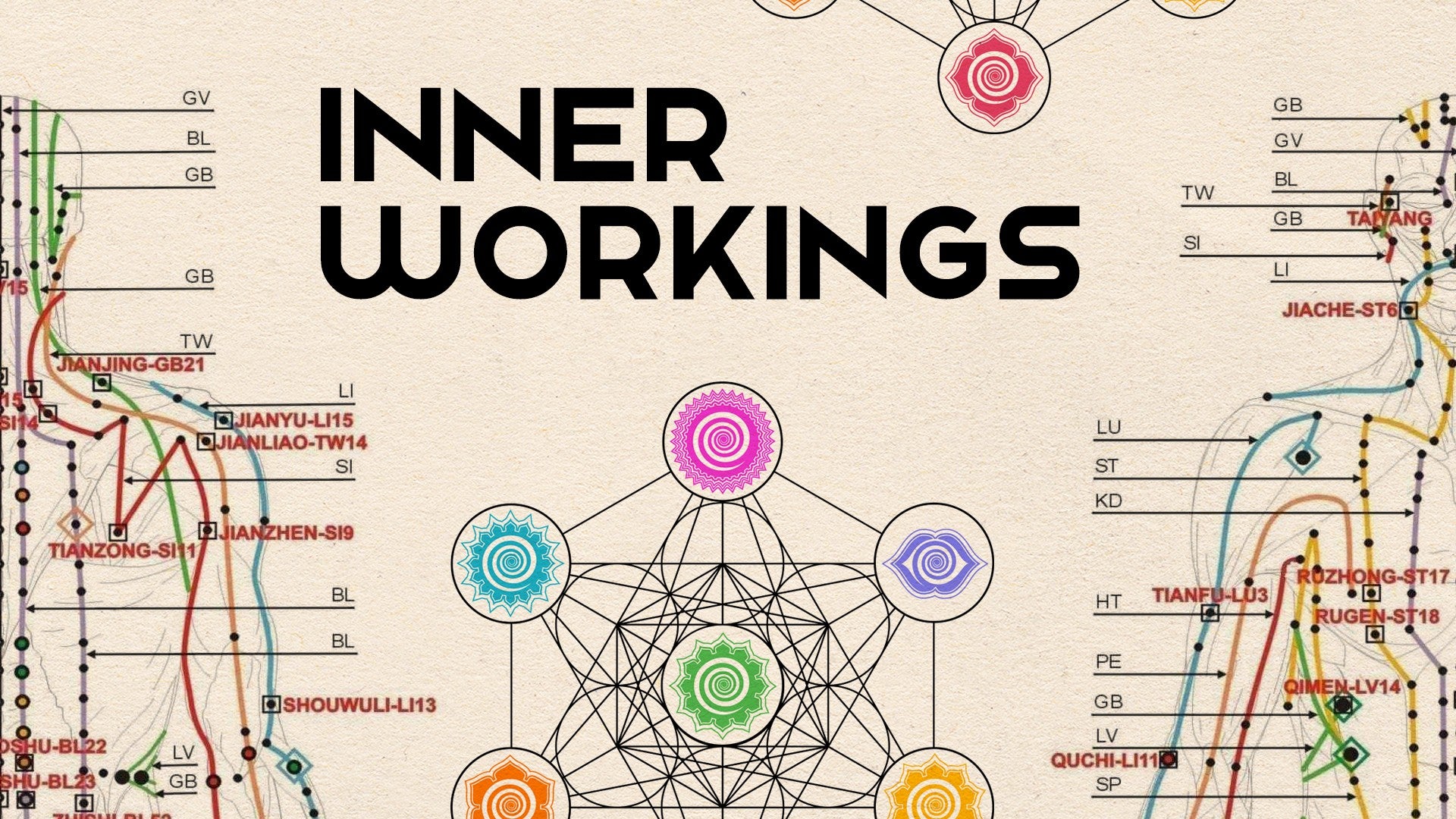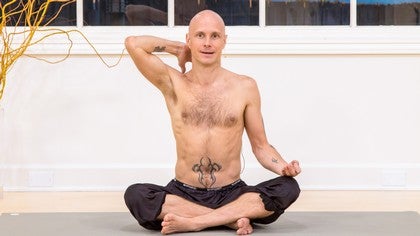Description
About This Video
Transcript
Read Full Transcript
Okay, so now we do practice for these Bandhas. So start with Down Dog, first tuck toes in and then slowly lift your buttock bones, back edge of the buttock bones up and then start to lower your heels, straighten legs and then concentrate first, Mula Bandha. So lift bottom of the pelvis up and towards the center, Ha, Mula Bandha, lengthen spine and then change, Ta, Mula Bandha. So lift, still perinoma up and away from the center, center line of the body. And then hold this for a while.
So you can repeat the action with an inhalation, do Ha, Mula Bandha, perinoma up towards the center when you exhale, do Ta, Mula Bandha, perinoma up and away from the center. Inhale, Ha, exhale, Ta. Inhale, Ha, exhale, Ta. And then exhale, knees down, come on your fore, okay. And then Vidala is in a cow pose.
And now concentrate on Udeana Bandha. So when you inhale, first pull lower abdomen in and up and then lower abdomen towards the center when you curve your back. So this is Ha, Udeana Bandha. That's the neck. And then Maria Rias on a cat pose, exhale, release.
When you do the cat pose, then it's Ta, Udeana Bandha. So lower abdomen in, up and away from the center, open chest forward and up. You can look up between the eyebrows, work with the Udeana Bandha, lower abdomen in, up and away from the center and then again change, Ha, Udeana Bandha. So lower abdomen towards the center and exhale, relax shoulders. Relax neck for the upper arms out.
And then inhale, again Ta, Udeana Bandha, lower abdomen away from the center, open chest stand them up and exhale, release. Then tuck toes in, inhale, lift, knees, exhale, go down. And bring hands under the shoulders, tuck tailbone down and then Kati Bandha. So inhale, when you go up, move hips towards each other, Ha, Kati Bandha, open chest, your rotate upper arms out and exhale. And then when you are in the pose, then inhale, move hips away from each other.
And exhale, inhale, move hips away from each other, try to make space, your lumbar spine, rotate upper arms out, open chest and exhale. And then exhale, and then come down. And then vinyasa, so inhale, open chest, exhale, down dog, lift, groins. And then inhale, bend knees, look forward, lift very numb up, Ha, Udeana Bandha and jump, exhale, okay. And then Paschimaptasana, so open soul of the food.
And then Hamala Bandha, lift very numb up, lengthen spine and exhale. And then inhale, take your shins or your feet, open chest and exhale, bend forward. Now try to activate Ta, Udeana Bandha, lower abdomen, in, up and away from the center. And exhale, relax neck. And then initiate, Ha, Swati Stana Bandha.
So do same way as you do when you hold the P, try to do that accent and then lengthen spine, lift up and towards the center. And relax neck, hold couple of breaths. When you inhale, you can try to do Ha, Mula Bandha, when you exhale, do Ta. And then inhale, come up, Ha, Mula Bandha and exhale, release. Then point the toes through the upper arms out, open chest through the shoulders, shoulder blades down, you can stay here, or if you can lift pelvis up, and when you lift hips, now try to move hips towards each other.
So this is Ha, Kati Bandha, the roots of the fingers down, like tailbone down, deep sternum up, hold, try to move inner thighs down, Ha, Mula Bandha, Ta, Udeana Bandha, Ha, Kati Bandha. And exhale, Badak Stana. And then inhale, bring heels next to perineum, and then press center of Badak bones down. And then Mula Bandha is Ha, perineum up, and then exhale, bend forward, Udeana Bandha is Ta, lower abdomen in, up, and from the center towards the sides. Side rotate front thighs out, sides long, spine long, and then work with your Mula Dharabanda.
So contract the anus, lift it up towards the center in order to support backman accent. And then inhale, slowly come up, keep spine long, and exhale, release. And then inhale, initiate Ha, Udeana Bandha, lower abdomen in, up, and from the sides towards the navel, and then bend forward. Rotate upper arms out, press out, the groin down, sternum up. So try to keep front side of the body long.
Mula Bandha is Ha, Udeana Bandha, so Rimala Bandha is Ta, Udeana Bandha is Ha. Then inhale, slowly come up, lengthen spine, and exhale, release. And then Navasana, both, pause. So take your knees, press center of Badak bones down, and then lift legs up. You can stay here, this is first option, or if you can, slowly straighten leg, open shoulders of the foot, lift sternum up, and perineum up.
Try to keep way middle of your Badak bones, perineum towards the crown of the head, Rimala Bandha, Ta, Udeana Bandha, sternum up, forward and up, and then take your knees, and exhale, come down. And then left heel next to right Badak bone, and then right foot over your left knee, then with your left hand take your right knee, lift sternum up, twist to the right from the shoulders. If you can, you can try to bring left elbow outside of the right knee, and then take your left knee or right foot out of the foot, and then start to twist from the shoulder line, twist to the right, Adha Matsyentrasana. So keep both Badak bones down, Mula Bandha is Ha, Udeana Bandha is Ta, and then Mula Dharabanda. First Ha, contract the anus, lift it up towards the center, and then Ta, contract the anus, lift it up and away from the center, and exhale release, and then change the side.
So right heel next to left Badak bone, and then with your right hand take your left knee, lift sternum up, open chest, if you can elbow outside, you can take your knee or out foot, and then twist to the left. Lift very numb up, towards the center, spine is lengthening, then lift very numb up, away from the center. So the sides start to move away from each other. And then pull lower abdomen in, towards the spine, up, towards the crown of the head, and from navel towards the sides. So the sides are moving slightly back, and exhale release.
And then left heel next to right Badak bone, and then you can take your right shin or your strap or take your foot, and then inhale straight and right leg. So first work with the Mulabanda, Mulabanda is Ha, Uriyana Bandha is Ta, and the Mulad Harabanda first Ha, and then change Ta, roll shoulders back, open chest. You can try to press your thigh bone against the hip socket, and same time try to lift right heel up. So right thigh bone against the hip socket, and heel up, and exhale release. And then other side.
So right heel next to left Badak bone, and your shin or your foot, lift along with the pelvis up, Mulabanda Ha, perinum up, towards the center, Uriyana Bandha Ta, lower abdomen in, and away from the center, and then Mulad Harabanda contract the anus, lift it up first towards the center, and then change the direction away from the center in order to open upper back. Inhale, and exhale release. And then cross the shins from the middle, lift stay in a map, keep sides long, spine long, and then inhale, exhale, push root of the index finger forward, Paravatasana, with the upper arms out, and then little bit play with the Uriyana Bandha. So lower abdomen away from the center, and then lower abdomen towards the center. Lower abdomen away from the center, lower abdomen towards the center, and then away from the center, and hold.
And then Mulabanda, lift up, perinum up towards the crown of the head, half Mulabanda, then change star, perinum up away from the center. And exhale, arms down, okay, then bring hands on the knees, and then we go through all these wonders, what we just learned. So first, focus on the pelvic floor, and then lift perinum up towards the center, spine is lengthening, and then perinum up away from the center, sides move away from each other, and then relax, and then contract anus, lift it up towards the center, lower back start to arts, contract anus, lift it up away from the center, upper back, start to bend back, and then relax, okay. And then Swadistana Bandha, do like when you do, when you hold your feet, and then lift it up towards the center, lower back start to convex, and then lift up and away from the center, upper back start to curve, and exhale release. Then Uriana Bandha, so pull lower abdomen in, and up, just below the navel, away from the center, this supports the back bend, and then lower abdomen towards the center, and this Bandha supports the forward, forward bend, Uriana Bandha, and exhale release, and then Kati Bandha.
So inhale, keep buttock bones as they are, don't move buttock bones, then try to move hips away from each other, right side and left side of the pelvis moving out, and then relax, and still keep your buttock bones down, and then move your right side and left side of the pelvis moving towards each other without moving buttock bones in, don't squeeze the buttock bones, only work with the hips, and then again hips away from each other, tah Kati Bandha, and then hips towards each other, tah Kati Bandha, and exhale release, and relax shoulders and neck. Okay, so this was short practice for the Bandhas, and when working with the Bandhas it just takes lots of time and repetition to really get into that, and then it helps, many times it helps if you just disconnect, when you do the Bandhas, try to, first when you start to practice you can just work with the one Bandha at that time, so that disconnect everything else, yoga means connect, but sometimes yoga is also disconnecting, also yoga should speak about this, if you define the word yoga it comes from the root yuj, which means to join, but potentially defines the goal of the yoga, in one words he defines the Kaivalya, one translation is indifference, which means basically that disconnect, so it's funny yoga is to connect, but same time goal of the yoga is to disconnect, so also when we do asana practice sometimes we connect, but sometimes it's actually good to try to disconnect, especially when we practice Bandhas it's good first to disconnect everything else, just focus on what you, and that particular Bandha, and then later connect to other Bandhas. Okay, thank you. Namaste.
Inner Workings: Jani Jaatinen & Ricky Tran
Comments
If this does not help, we can translate. Glad you are here. xokira
You need to be a subscriber to post a comment.
Please Log In or Create an Account to start your free trial.












